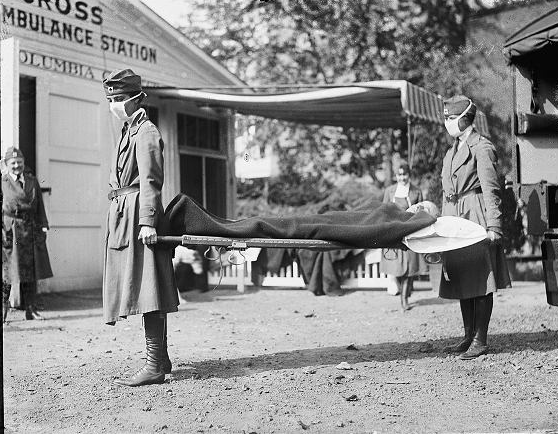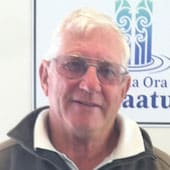The Influenza Epidemic killed a greater proportion of Māori, some 2,500 out of a population in the low 40,000’s. This was about seven times the casualty rate of that amongst the European (Pākehā) population. The 1890 Influenza epidemic claimed hundreds of Māori lives. Over time various diseases reduced Māori population to an all-time low at the end of the 19th Century. Some forecast that Māori would die out altogether.
Fortunately some sought to address the concern. One of the key players was the Headmaster of Te Aute College, John Thornton. He fought to establish a school which would enable Māori to graduate from University. The first graduate was Apirana Ngata who graduated with a B.A. in 1893 from Canterbury followed by a LLB at Auckland in 1896. The first doctor spent some time at Te Aute. He was Maui Pomare who trained through the influence of the Seventh Adventist Church at the American Medical Missionary College at Chicago. At Te Aute he was introduced to Health for the Maori written by the Inspector for Native Schools, James Pope.
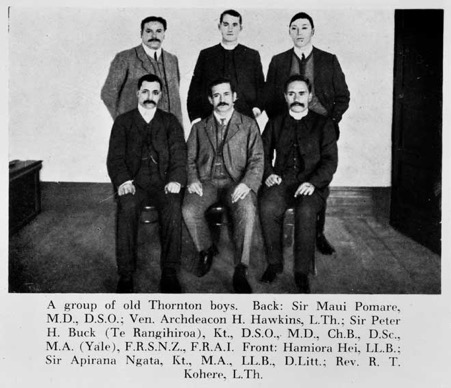
This was a catalyst for students to debate issues they could address and they became zealous to improve their own people’s health. Under the tutelage of John Thornton, the Te Aute College Students’ Association was formed which proposed Māori nurses (in those days usually referred to as natives) and later became the Young Māori Party. One of its members was Hamiora Hei, brother to Akenehi Hei, the first Māori registered nurse. Another initiative was to offer scholarships for training at Otago Medical School. Peter Buck and Tutere Wi Pera received these and became doctors. My second victim of the Influenza also won one of these scholarships but didn’t complete the Medical Course.
Rongo Nuku came from Whakatāne. The farm of his parents Hoani and Iritana Nuku is held in trust and is on Nuku Road off State Highway 2, close to the Peketahi Bridge. Rongo was a member of the Te Aute College rugby team which made the very first school (from New Zealand) overseas tour, to Australia in 1904. . It was led by the headmaster, John Thornton, and the captain was the head boy, Pine Tamahori, father of Canon John Thornton Tamahori. In 1907 Rongo won a scholarship to Otago Medical School and gained a place in the Otago University Rugby team and again toured Australia with the Universities team in 1908. In the University team photo for 1907 Dr Tutere Wi Repa was in the team but not present for the photo. Dr Wi Repa played for the team as a student then as a junior house surgeon at Dunedin Hospital from 1899 to 1907. The following year Rongo was in the side but was absent for the team photograph in 1908. (Maybe he had already left Dunedin when the photo was taken.)
At the beginning of 1904 Rongo passed the University of New Zealand’s Matriculation, Solicitors’ General Knowledge and Medical Preliminary Examination. The Poverty Bay Rugby Webpage would suggest he spent the year there in 1905, getting in the representative side, playing for West End Club. This was Tutere Wi Repa’s club. In the game which they lost against Hawkes’ Bay Rongo played half back. The Poverty Bay Herald lists him as passenger on the Zealandia in 1906, heading for southern ports with Wi Repa. He may have been at Te Rau College preparing for medical preliminaries like Drs Buck and Wi Repa. He decided to attend university and the Auckland Star reported his winning a medical scholarship in 1907:
“Mr Rongo Nuku, of Whakatane, Auckland, has been awarded a medical scholarship at Otago University; similar to those formerly held by Messrs. Buck and Wi Repa. The scholarship is tenable for five years, the holder receiving aboard allowance of £40 per year, with college and class fees, and an allowance not exceeding £10 per year for books, instruments, etc. He will commence his studies in April.”
A history of Otago University rugby notes “Newcomers to make an impression included Rongo Nuku,” and they won their opening game against Pirates 40-0. He soon became a favourite as the same history adds, “No football notes would be complete without a word about the pride of our hearts, the darling of the crowd, in a word – Nuku. Who wouldn’t walk 20 miles to see him dodge three men as easily as an eel?”
While at Otago, Rongo boarded with a Mrs Jane Patrick at 3 Albany Street, near the University. He is noted as speaking at the farewell to Dr Wi Repa when he was leaving to take up a post at Gisborne Hospital. It was at a meeting of the Young Māori Party and the doctor was presented with a “complete shaving set.” Also a fellow speaker was Hoani Parata, a Selwyn College member and who had recently been ordained. He was a nephew of Ned Parata who was to play a future role in Rongo’s life.
Rongo Nuku passed most of his papers, but they were third class passes and Rongo seems to have struggled. The 1907 Otago University Parliamentary contract. The Free Lance commented, “The Dominion may have gained a report numbered their students as 110 women and 171 men plus 32 non-matriculated students . The Free Lance states that the Gisborne Hospital Board’s treatment of Tutere Wi Repa was the final straw. Patients’ complaints of having a Maori doctor led the termination of his footballer, but it lost a Maori doctor. Don’t let us boast too loudly that we always treat our Maori fellow-citizen as a man and brother.”
After two years at Otago Rongo returned to Whakatāne. He became captain of a very successful Whakatāne Representative, winning all four games in 1910, scoring 63 points and conceding only 3. . Ned Parata included him in the 1910 Native team for a few games in New Zealand. He got himself into the first Bay of Plenty representative rugby side in 1911. At the Bay of Plenty Representative Rugby Centennial, he was given the number 1. Back in the Bay of Plenty, he came under the watchful eye of Maori Coach, Ned Parata. Parata nominated him for the North Island in their match against the South Island at Napier in 1912.
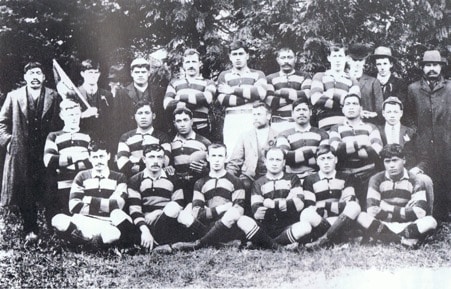
Rongo made the New Zealand Native (Māori) team which toured Australia in 1913. The pre-match publicity reads:
“The backs are equally strong. Rongo Nuku who has been over here with the Te Aute College team and with the New Zealand University team, has developed into a brilliant back, who is equally at home in any position.”
At the beginning of 1918 he bought a piece of land and this was to become an item of court news after his death as his father argued with the previous owner over the mortgage. Back in Whakatāne he was elected to the County Council.
On November 13 1918, the publican at the Commercial Hotel, William Regan and one of his paying guests, Land Court Judge T. H. Wilson were the first to die in Whakatāne as a result of contracting Influenza. They were cared for at the Anglican Māori Mission Hospital. Many more suffered and temporary tent hospitals had to be set up to cope. Rongo and his wife were part of the team which nursed patients of the Influenza outbreak at the temporary hospital at Poroporo along with his sister and nephew. On the same day, 27 November 1918, Rongo Nuku and his sister Te Huatahi Kingi and nephew Mokai Tuki all died.
Ned Parata, Rongo’s rugby mentor, came from Otago and his letter back home reporting their death was published in the Observer:
“The well-known Rugby enthusiast, Mr. Ned Parata, writing to a member of the Otago “Daily Times” staff from Rotorua, says: – “Our poor old friend Rongo Nuku (the ex-Otago University five-eights) passed away in Whakatane on November 27th through influenza practically through being overworked attending and nursing the sick amongst his people who have had a very bad time, hundreds of them being down with it. His wife, sister and nephew were some of the able ones helping him. His sister and nephew were buried the same day as he was; while his wife is seriously ill with it, too. I have lost a good friend in Nuku, a fine footballer, and one of the most unselfish players I knew, and a gentleman. He was one of the mainstays with regard to recruiting amongst the Maoris, and was also a member of the Whakatane County Council.”
They are buried in adjoining plots in the Old Whakatane Cemetery on Domain Road. I was amazed to see the obelisk on his grave now placed beside the inscription and the fallen angel beside Te Huatahi’s. There are 13 other Maori buried in this cemetery, they have neither plot number nor a headstone. Rongo’s wife also went down with the influenza but survived. I assume the grandparents helped her and William Kingi look after Rongo’s and Te Huatahi’s children. Rongo Nuku married and left a wife and four children. His grave is beside his sister’s and near his nephew in the Whakatane Cemetery on Domain Road.
“He lived in the service of his people and gave his life that others might live.”
Twenty years later, he was remembered as the “Rongo Nuku, the brilliant 5/8, who played for several years for Otago University.” One hundred years later may Rongo Nuku be remembered as one of those who died caring for others during the Influenza Epidemic of November 1918.
We may well ponder what if racial prejudice hadn’t dismissed Rongo’s friend, Dr Tutere Wi Repa, as a house surgeon in Gisborne Hospital in 1908. However the family think he ceased medical training because he couldn’t stand the sight of blood.
There was no further medical graduate until Edward (Ned) Pohau Ellison in 1919.
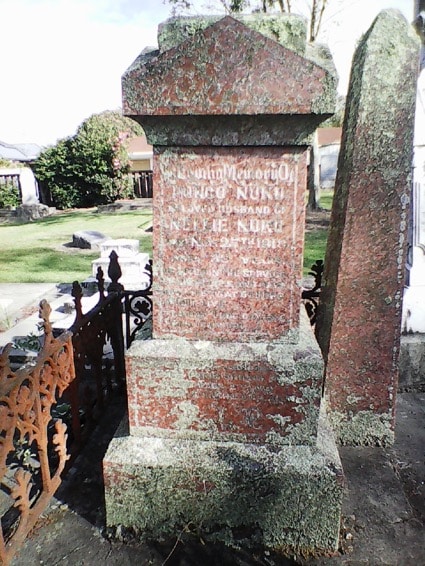
In Loving Memory of Rongo Nuku, beloved husband of Nellie Nuku died Nov. 27th 1918 aged 36 years. He lived in the service of his people and gave his life that others might live. The day thou gavest Lord is ended.

